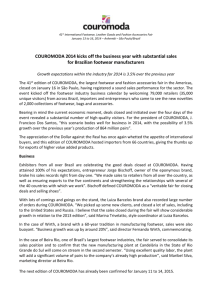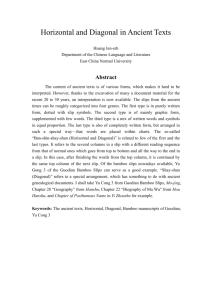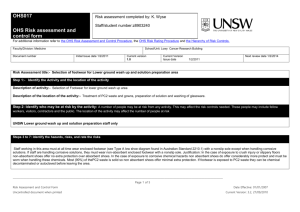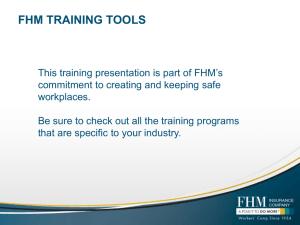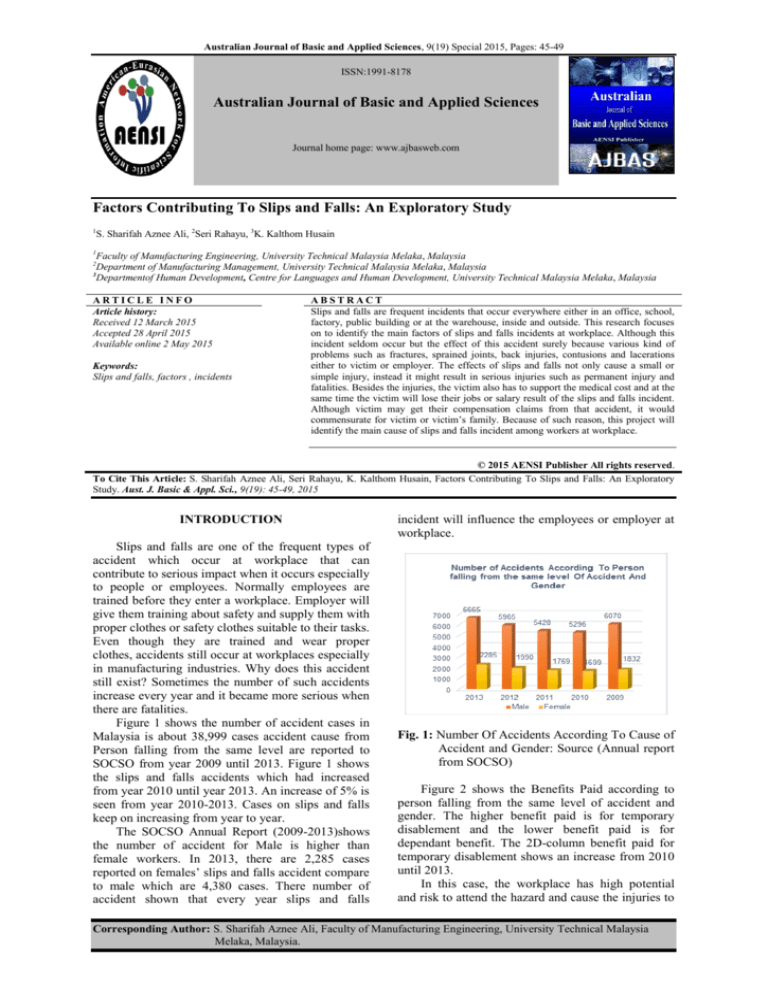
Australian Journal of Basic and Applied Sciences, 9(19) Special 2015, Pages: 45-49
ISSN:1991-8178
Australian Journal of Basic and Applied Sciences
Journal home page: www.ajbasweb.com
Factors Contributing To Slips and Falls: An Exploratory Study
1
S. Sharifah Aznee Ali, 2Seri Rahayu, 3K. Kalthom Husain
1
Faculty of Manufacturing Engineering, University Technical Malaysia Melaka, Malaysia
Department of Manufacturing Management, University Technical Malaysia Melaka, Malaysia
3
Departmentof Human Development, Centre for Languages and Human Development, University Technical Malaysia Melaka, Malaysia
2
ARTICLE INFO
Article history:
Received 12 March 2015
Accepted 28 April 2015
Available online 2 May 2015
Keywords:
Slips and falls, factors , incidents
ABSTRACT
Slips and falls are frequent incidents that occur everywhere either in an office, school,
factory, public building or at the warehouse, inside and outside. This research focuses
on to identify the main factors of slips and falls incidents at workplace. Although this
incident seldom occur but the effect of this accident surely because various kind of
problems such as fractures, sprained joints, back injuries, contusions and lacerations
either to victim or employer. The effects of slips and falls not only cause a small or
simple injury, instead it might result in serious injuries such as permanent injury and
fatalities. Besides the injuries, the victim also has to support the medical cost and at the
same time the victim will lose their jobs or salary result of the slips and falls incident.
Although victim may get their compensation claims from that accident, it would
commensurate for victim or victim’s family. Because of such reason, this project will
identify the main cause of slips and falls incident among workers at workplace.
© 2015 AENSI Publisher All rights reserved.
To Cite This Article: S. Sharifah Aznee Ali, Seri Rahayu, K. Kalthom Husain, Factors Contributing To Slips and Falls: An Exploratory
Study. Aust. J. Basic & Appl. Sci., 9(19): 45-49, 2015
INTRODUCTION
Slips and falls are one of the frequent types of
accident which occur at workplace that can
contribute to serious impact when it occurs especially
to people or employees. Normally employees are
trained before they enter a workplace. Employer will
give them training about safety and supply them with
proper clothes or safety clothes suitable to their tasks.
Even though they are trained and wear proper
clothes, accidents still occur at workplaces especially
in manufacturing industries. Why does this accident
still exist? Sometimes the number of such accidents
increase every year and it became more serious when
there are fatalities.
Figure 1 shows the number of accident cases in
Malaysia is about 38,999 cases accident cause from
Person falling from the same level are reported to
SOCSO from year 2009 until 2013. Figure 1 shows
the slips and falls accidents which had increased
from year 2010 until year 2013. An increase of 5% is
seen from year 2010-2013. Cases on slips and falls
keep on increasing from year to year.
The SOCSO Annual Report (2009-2013)shows
the number of accident for Male is higher than
female workers. In 2013, there are 2,285 cases
reported on females’ slips and falls accident compare
to male which are 4,380 cases. There number of
accident shown that every year slips and falls
incident will influence the employees or employer at
workplace.
Fig. 1: Number Of Accidents According To Cause of
Accident and Gender: Source (Annual report
from SOCSO)
Figure 2 shows the Benefits Paid according to
person falling from the same level of accident and
gender. The higher benefit paid is for temporary
disablement and the lower benefit paid is for
dependant benefit. The 2D-column benefit paid for
temporary disablement shows an increase from 2010
until 2013.
In this case, the workplace has high potential
and risk to attend the hazard and cause the injuries to
Corresponding Author: S. Sharifah Aznee Ali, Faculty of Manufacturing Engineering, University Technical Malaysia
Melaka, Malaysia.
46
S. Sharifah Aznee Ali et al, 2015
Australian Journal of Basic and Applied Sciences, 9(19) Special 2015, Pages: 45-49
the employees. If the employees are not sensitive or
avoid the safety rules or put on proper safety
apparatus, they might be the victims of slips and fall
accident.
Fig. 2: Benefit Paid According To Slips and Falls
Accident:Source (Annual report from
SOCSO).
Besides injuries, employer may face the loss of
manpower. Their employees might not fit well to
their jobs and get the medical certificate or leave the
jobs. So by that time factory will face the less
manpower especially if it involves skill workers. So
these problems will affect the production department.
On the other hand, if there are a lots of slips and falls
problems, the company also could spend plenty of
money for compensation claim from employees.
So, this study is carried out to identify the
factors why slips and falls occur at work place. What
are the main causes of slips and falls? Why these
accidents happen and how to reduce the number of
cases.
Factors:
From the survey conducted at factory visit on 3rd
September 2009 at SCA Hygiene Malaysia Sdn. Bhd.
at No. 3, Jalan Gicing Hulu 28/33, Hicom Industrial
Estate Sektor C, Seksyen 28, Taman Alam Megah,
40400 Shah Alam Selangor there are several factors
that contribute to slips and falls at the workplace.
The factors are floor, footwear, cleaning process,
human or people and environment.Most of the
respondents agreed that these 5 factors are closely
related to slip and fall accidents.
Flooring is a main factor to contribute to slips
and falls among workers. Ralph L. Barnett, Suzanne
A. Glowiak and Peter J. Poczynok (2003), Ralph L.
Barnett and Peter J. Poczynok (2004) andRalph L.
Barnett and Suzanne A. Glowiak (2005) highlighted
that the more active pathways and the longer
pathways will produce the most slips.The surface
roughness of the floor is measured and identifies to
prove that if the surface roughness less than 10m
means that floor have high potential for slips and
falls to occur. However from the experiment, it
shows that most of the surface roughness at the
company and also at the Fitting laboratory is less
than 10m. Although the surface roughness value
less than 10m it does not mean that those person or
people walking on that surface will experience slips
and falls incidents immediately. Slip and fall incident
will occur with combination other factors too.
Second factor is footwear. Roughness of
footwear was measured to identify the potential slips
and falls. This will affect friction and slip resistance.
From both sample of footwear’s, new and old
footwear. So, both types of footwear are used in the
experiment slips and fall at the Fitting laboratory.
The roughness of the new footwear is higher than the
old footwear. According to Research by the Health
and Safety Laboratory (HSL) on behalf of Health and
Safety Executive (HSE), table 1 Dr Marianne LooMorrey (2007) showSlips potential classification
related to floor surface slipperiness in watercontaminated conditions. If there are other
contaminated, differing levels of roughness will be
needed to lower slip potential. As a general rule, a
higher level of surface roughness is needed to
maintain slip resistance with a more viscous (thicker)
contaminant.
Table 1: Slips potential classification, based on Ra micro roughness values
Ra surface roughness
Below 10 m
10 – 20 m
20 + m
Cleaning process is a third factor that contributes
to slip and fall incident. Cleaning involve cleaning
procedure at the workplace. Normally they used
water, detergent and oil as a source. On the other
hand if there is some leaking from the machine or
there is some spill on the floor, cleaning jobs are
carried out to make sure that slip and fall incident
can be avoided by proper and immediate action from
housekeeping department. By using similar material
such as water, water and detergent and oil as a liquid,
Slip Potential
High
Moderate
Low
the third factor will be tested together with the two
factors mentioned earlier.
The fourth factor is human or people. Human
vary widely to relate them to slips and falls incidents.
This is because of several criteria that can be
expected such as gender, weight, height, ageing,
personal health, style of walking and so on. Every
person has different criteria personality. Rarely
among human or person have the same criteria even
though they are twins. Sometimes if they are in the
47
S. Sharifah Aznee Ali et al, 2015
Australian Journal of Basic and Applied Sciences, 9(19) Special 2015, Pages: 45-49
same weight and age, but maybe their health
condition is not similar. Meaning those factors
contribute and cause different incident in slip and
fall.
Finally environment is the fifth factor that
contribute to slips and falls incident at the workplace.
Temperature, lighting and arrangement of apparatus
or machine are criteria in the environment. This
factor can contribute to slips and falls incident such
as insufficient lighting level especially near the office
area or walkway is littered with thick wires or spill
with oily or water that create an obvious slippery
hazard. Hence, this factor also need to be considered
to avoid or reduce slip and fall incident at workplace.
Experiment:
The floor is used as a main factor but human,
footwear and types of liquid are used as a variable
method. There are three persons who are subjects in
the testing, four types of liquid, each type of liquid is
tested in five different quantities from 100ml to
500ml and the test involve two different type of
footwear. However there is also an experiment on a
person who has to walk on targeted step without any
footwear.
Table 2: Water and Combination Water + Detergent testing result.
Quantity Liquid/
Water
Person/ Footwear
Person 3
WOF
NF
OF
100ml
20cm
NS
NS
200ml
15cm
NS
NS
300ml
25cm
NS
NS
400ml
30cm
NS
NS
500ml
35cm
NS
8cm
WOF - Without footwear, NF - New footwear, OF - Old footwear, NS - Non Slipping
Table 3: Sharlu oil testing result.
Quantity Liquid/
Sharlu oil (cm)
Person/
Person 1
Person 2
Footwear
WOF
WOF
NF
OF
100ml
57
43
NS
25
200ml
62
53
30
25
300ml
81
71
29
30
400ml
63
49
NS
35
500ml
64
51
5
36
WOF - Without footwear, NF - New footwear, OF - Old footwear, NS - Non Slipping
Table 4: Castrol oil testing result.
Quantity Liquid/
Castrol oil (cm)
Person /
Person 1
Person 2
Footwear
WOF
WOF
NF
OF
100ml
30
79
NS
NS
200ml
46
56
NS
NS
300ml
59
63
25
28
400ml
60
71
25
30
500ml
64
48
NS
32
WOF - Without footwear, NF - New footwear, OF - Old footwear, NS - Non Slipping
The result from the testing show that by using
water as a liquid, there are no slip for person no. 1
and person no. 2. But for the third person, slip occur
for him when he is not wear any footwear and with
wearing old footwear(Table 2). There are slips
potential when the person no 3 wearing old footwear
and without wearing any footwear especially by
using combination of water and detergent as a liquid
(Table 2). For liquids like Sharlu oil (Table 3) and
Castrol oil (Table 4), there are some differences
compared to water and combination water and
detergent as a liquid. This type of oil result in slip for
all the three person when they walk without wearing
any footwear. However, when wearing old footwear
and new footwear, only person no. 2 and person no. 3
face slip during testing.
From the result, there are four main criteria that
can be discussed in detail. The first condition is
WOF
NS
15cm
NS
NS
NS
Water + Detergent
Person 3
NF
NS
NS
NS
NS
NS
WOF
70
62
102
83
89
WOF
55
68
85
90
98
OF
NS
13cm
15cm
NS
NS
Person 3
NF
17
21
22
25
18
OF
33
12
23
24
28
Person 3
NF
5
2
3
50
28
OF
15
3
17
36
27
wearing either new footwear, old footwear or without
wearing any footwear. The second criterion is weight
of human or person which are the weight of three
different person from 65kg, 70kg and 80kg. A third
criterion is aging for each person which is the subject
no. 1 and no 2 who are 22 years old. However
subject no. 3 is 34 years old. Fourth criteria is
different type of liquid that were four different type
of liquid such as water, water and detergent, Sharlu
oil and Castrol oil.
The result shows that human will have high
potential to slip and fall when they are not wearing
any footwear especially when they are walking on
oily surface. On the other hand, if they were wearing
new footwear the risk is less compared to wearing an
old footwear. This is because footwear became
polished during walking on oily and wet floor
surfaces. The old footwear will reduce friction.
48
S. Sharifah Aznee Ali et al, 2015
Australian Journal of Basic and Applied Sciences, 9(19) Special 2015, Pages: 45-49
Coefficient of friction (COF) means the ratio of the
weight of an object being moved along a surface and
the force that maintains contact between the object
and the surface. For this case slip is the opposite of
friction. "High slip" denotes low COF and low slip
denotes a high COF. From Figure 3 byRogerHaslam
and David Stubbs (2006), slip may begin when the
ratio of horizontal and vertical force component
(FH/FV) exceeds the Friction force divide the normal
Force (Fµ/FN).
Fig. 3: Minimum friction coefficient for slip
avoidance based on the equilibrium of
force at heel contact. (From Gronqvist,
R., Chang, W.R., Courtney, T.K.,
Leamon, T.B., and Strandberg, L., 2001c,
Ergonomics, 44,
1102-1117.)
Second condition is the weight of human or
person. From the test, it clearly shown that subject
no. 3 almost occur slip in every type of liquid and
while not wear any footwear and wear an old
footwear. However with wearing new footwear
sometimes there was slip especially for oily surface
but rarely to new footwear. This means that weight
of human is a factor to cause a slip and fall incident.
When somebody is heavy by weight, that person
have high potential to experience slip and fall
compare to person who is less heavy by weight. The
weight for subject no. 3 is 80kg compare to other
persons on who weights 65kg and 70kg. Meaning,
when a person is heavy by weight the person might
face a balance problem hence difficulty to control or
balance of themselves. Besides that overweight also
cause lower body weakness and sometime every
person have their own style of walking or gait.
Third criterion is aging. These three people have
different age which is the first and second person;
their age is around 22 years old compare to third
person which is 34 years old. Among older people,
the risk of falling increases with age. Meaning that
older person will have high potential to occur slip
and fall compare to younger people. This is because
when the person became older, the body strength,
stamina, balance and other risks could be
experienced also.As claimed by Bailer, Stout, Reed
& Gilbert (2001) that age, sex and frailty is relate to
fall.
Fourth criteria is different type of liquid which
consisted of four different type of liquid such as
water, water and detergent, Sharlu oil and Castrol oil.
These type of liquid, oil has high potential to occur
slip compare to water and combination water with
detergent. Normally when there was spill of water, if
the spill of water is not immediately cleaned, after
some time the water will dry itself. However if there
was spill of oily, after some time it will not dry itself
and it will effect of mossy surface. The mossy
surface is dangerous for everybody who walks
through such an area because oil will adhere on the
surface either floor or footwear surface.
Conclusions:
Slip and fall accidents resulted in permanent
serious injuries and fatalities. The effect factors to
slip and fall include floor, footwear, cleaning
process, human or people and environment.
Everyone or all employees who may be required to
work in a higher risk area must be trained on the
recognition of potential hazards associated with
working in a higher risk area and use of control
measures to prevent slip, trip and fall related
accidents.
Recommendations:
a. Study include both gender among employees in
factories, therefore comparison either male or female
have a high potential to slip and fall at work place.
b. The weight can be expand from 40kg until 90kg
would give different results to show the relationship
between weights and potential of slip and fall.
c. Make a study about slips and falls at school area
at the same time can give pupils basic knowledge on
slip and fall and teach them to avoid the incidents.
REFERENCES
Bailer, Stout, Reed, Gilbert, 2001. Falls in Older
People: Risk Factors and Strategies for Prevention.
Cambridge University Press.
Dr Marianne Loo-Morrey, 2007. A study of the
slip characteristics of natural and manmade stone
flooring materials.Health and Safety Executive.
Ralph Barnett, L. and A. Suzanne Glowiak,
2005. Extreme Value Formulation of Human Slip: A
Summary. Triodyne Safety Brief. Volume 27 No. 4.
Ralph Barnett, L. and J. Peter Poczynok, 2004.
Slip and Fall Characterization of Floors. Triodyne
Safety Brief. Volume 26 No. 2.
Ralph Barnett, L., A. Suzanne Glowiak and J.
Peter Poczynok, 2003. Stochastic Theory of Human
Slipping. Triodyne Safety Bulletin. Volume 22 No.
4.
49
S. Sharifah Aznee Ali et al, 2015
Australian Journal of Basic and Applied Sciences, 9(19) Special 2015, Pages: 45-49
Roger Haslam and David Stubbs, 2006.
Understanding and Preventing Falls. Taylor &
Francis Group.
SOCSO Annual Report (2009-2013).Ministry of
Human Resources

